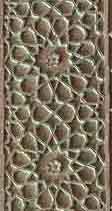FURTHER
RESOURCES:
RECOMMENDED
BOOKS:
*Ainslie T. Embree, ed. Alberuni's
India. New York: W. W. Norton, 1971.
ONLINE
BOOKS:
*ALBIRUNI's great book
"Tarikh al-Hind"
(c.1030, Ghazni), trans. by Edward C. Sachau (1910): volume 1: [site];
volume 2: [site]
*Annemarie Schimmel. Islam
in the
Indian Subcontinent. Leiden: E. J. Brill, 1980: online
through NetLibrary. Within their system, here is the exact
location.
*Sana'i of Ghazna, Hakim
Abu' l-Majid
Majdud. The Hadiqatu' l-Haqiqat (The Enclosed Garden of the
Truth).
J. Stephenson, ed. and trans., 1910. Online through sacred-texts.com.
Another great Sufi saint of Ghazni, who lived in the mid-1100s.
WEBSITES:
*An art-historical timeline
of South
Asian history: at
the Metropolitan Museum.
*A comprehensive website on
the famous
Silk Road trade route: Silk-Road.
*A lucid map of Central
Asia, with
display choices: grifterrec.com.
*The best website on
Central Asia,
by Prof. Dan Waugh: at
Univ. of Washington.
*Some gorgeous photos of
Afghanistan: by
Luke Powell.
*The great Buddhas of
Bamian, a site
that lasted through centuries of Muslim rule and was destroyed only by
the Taliban: an
art-historical overview and tour.
*A brief account of
Ghaznavid architecture:
in a website devoted to Persian
cultural history.
*Some images of Ghazni
(images 13-19)
by Dr.
V. Thewalt. They include a very Indic-looking elephant,
and a scene of real desolation.
*A look at the Hindu and
Buddhist temples
of the Salt Range Mountains in Pakistan, dating from the 6th c to the
early
11th c: at Univ.
of Pennsylvania.
*An online history of
Pakistan. Notice
the jump between the second item on the timeline in the left frame, and
the third one: at storyofpakistan.com.



